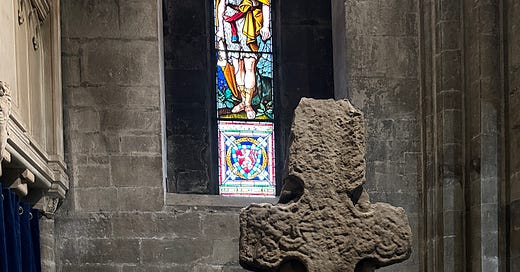If you transported yourself through time to the 10th century, there would be no Scotland.
Well, at least not as we know it today.
Prior to the 11th century—and arguably creeping further into the Middle Ages—Scotland was made up of different territories. There was no one kingdom. When the failed Roman occupation of Scotland departed c.211AD, the lines and boundaries of these territories became clearer and expanded.
This included Dál Riada, a kingdom spanning the Irish Sea from the northern reaches of Ireland to the west coast and islands of Scotland. In the east, the Picts dominated the land north of the River Forth, while the Kingdom of Northumbria ebbed and flowed over central and south east Scotland.
Today, I want to tell you about another kingdom which rose to power from the 9th century, and one of three stone crosses that survived from its tenure: the Kingdom of Strathclyde.
The exact dates for the rise and fall of the Kingdom of Strathclyde are murky—as many things are for this period in Scottish history—but we know that this early medieval kingdom was enacting power in the 9th century. While its capitals were found at Dumbarton Rock and Govan, Strathclyde’s territory stretched from Loch Lomond to the Lake District, and was referred to by Welsh tribes as ‘the Old North’. The inclusion of Cumbria in Strathclyde’s dominion explains why later Kings of Scots laid claim to this region in modern-day England.
Strathclyde seems to have fallen when it was subsumed by the Kingdom of Alba in the 11th century, the foundation of what would become the Kingdom of Scotland. However, archaeological evidence survived Strathclyde, including the incredible Govan Stones (a newsletter for another day). Today, let’s take a look at another survivor of the ancient Kingdom of Strathclyde: the Barochan Cross.


The Barochan Cross is magnificent. Dated to the 9th-11th centuries, this cross was originally discovered on a key route which linked Paisley to Dumbarton, intersecting with the road from Govan and a route to Kilalan, the site of an ancient church of St Fillan. Thus, we can assume that the cross was a significant symbol of authority and religion which marked a major road connecting central locations of the Kingdom of Strathclyde.
In the 1850s, the cross was moved to the top of Corslie Hill, above its original sheltered location, leaving it exposed to the Scottish elements. This caused considerable damage to the cross, and in 1981 it was moved inside Paisley Abbey to be protected from further destruction.
While the cross is an obvious Christian symbol—Christianity was well and truly established in Scotland by the 9th century—the carvings on the cross don’t appear to show any religious symbolism. A spear-armed horseman, an axe-wielding warrior, and five figures blowing or perhaps drinking from horns, are especially strong martial imagery. There is also a depiction of two great beasts fighting, possibly symbolising two armies or kingdoms.
Four robed figures may be priests, thus referencing religious symbolism, but this a stone cross which clearly conveys military power and authority. If we consider this with the stone’s original location on a major route intersection in the Kingdom of Strathclyde, then we could conclude that the cross was commissioned by nobility or even the royal family of Strathclyde. Symbols of authority were a crucial element of early medieval lordship in Scotland, and this cross certainly fits the bill.


It’s easy to think of the lost kingdoms of Scotland between the Romans and the 11th century as primitive or uneducated. All too often, this period is described as the ‘dark’ age. And yet, when we see these stone crosses with their incredible carvings and we consider their chosen location, all within the context of other archaeological wonders, I find it remarkable that so many still view the people of this period as primitive. Yes, there are many questions unanswered, but these survivors speak to the culture of politics, artistry, religion, and ambition that we continue to see over the centuries in Scotland.
The Barochan Cross may rest quietly in the gloom of Paisley Abbey today, but it is a lasting symbol of a once powerful people who dominated swathes of Scotland and northern England.




Quite thought provoking! Corslie Hill is Between Houston and Langbank. I find these ancient routes fascinating in context of where we travel today without thought! SO looking forward to a piece on The Govan Stones - a real treasure to seen in Govan, Glasgow!
Having spent all my life connected to Scotland although not always living there, I love this!